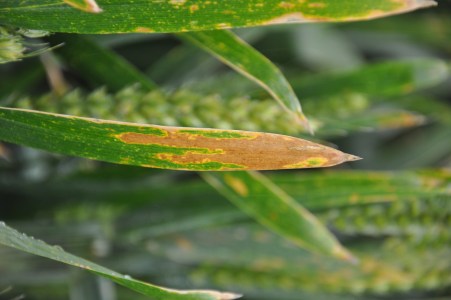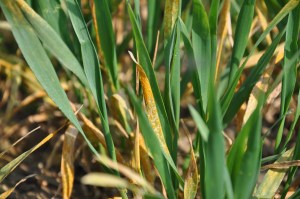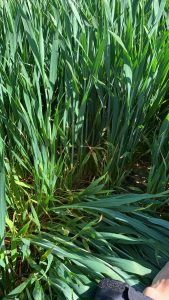The early bird catches the worm – so the saying goes, and this is no truer than when applied to getting ahead of disease in cereal crops. CPM explores how targeted early season agronomy can make all the difference.
“Less green leaf area means reduced yield-building ability.”
By Melanie Jenkins

According to Joe Bagshaw, crops are most at risk from disease between T1 and T2, so protection against disease at T1 helps to insure against late weather volatility.
Growers may have speculated about whether the country has been duped by a false spring this February, which – at the time of print – is still in question. But one thing the balmy February days have highlighted is that farmers still live with uncertainty on a daily basis.
According to Joe Bagshaw of Syngenta, over the past five years it’s been hard for growers to make decisions about early season disease agronomy because it’s been so dry. “Knowing how much disease might impact a crop in spring can be down to drill date and variety choice. Although location has a big impact, this can’t be easily changed.
But one way or another, there’s always enough inoculum in a crop to create an epidemic, so the temperatures and rainfall between March and May can have a big impact on septoria and yellow rust outbreaks. The biggest risk time is between T1 and T2, so protection against disease at T1 is to insure yourself against late weather volatility.”
For this very reason, independent agronomist Ruth East stresses the importance of proactively dealing with disease in winter wheat. “It’s vital to be on top of disease because there’s a pathogen living in the plant and if you let it develop, you’ll never get control over it. Fungicides won’t totally eradicate disease, so there’s always pathogens in the plant, meaning the right conditions will allow them to develop.”

A stressed crop will respire instead of photosynthesising, which in turn makes it more vulnerable to disease infection.
Another benefit of keeping disease under control is to stop crops going into stress mode, says Ruth. “A stressed crop will respire instead of photosynthesising, which in turn makes it more vulnerable to disease infection.
“If a crop is well established with a good rooting system, then it’s able to use nutrients better and access water more efficiently, as well as being able to build up green leaf area and canopy, and therefore can better withstand stress conditions.”
Optimising chemical applications is a key tool in tackling disease, but planning management can be perceived as more difficult for some diseases than others due to their unpredictability. “Septoria is more predictable than yellow rust as it’s latent period is driven by temperature and moisture,” explains Ruth.
Since the Warrior race incursion in 2011, which marked the end of the clonal lineage which used to dominate in the UK, yellow rust has become much more adaptable and able to withstand greater changes in the environment.
The Warrior race can tolerate a greater range of temperatures, it has a shorter infection time, which means there is potential for the disease cycle to repeat several times during a season, and it’s much more aggressive, producing more spores than the ‘old’ yellow rust.
Ruth believes all yellow rust races prefer different weather conditions – some like higher and others prefer lower temperatures. “Yellow rust is tricky because of the variation we have in races now. Plus the virulence varies between genotypes so growers want to be targeting it early, at the T0 timing.”
As of mid-February, Ruth had already seen yellow rust in the field. “The temperature is now warm enough for the disease to sporulate – typically from 7 to 10˚C. And as virulence can change, the disease can overcome even stronger varietal resistance, so you can’t rely on that.”

As the likelihood of septoria infection can be predicted the key control points are at leaf three and leaf one emergence.
According to Joe, based on 21 years of data on disease in the AHDB Recommended List winter wheat trials, the real levels of septoria in crops has remained pretty flat, but the amount of yellow and brown rust present is creeping upwards. “A lot of varieties with good ratings are steadily getting more disease in them – so monitor your varieties on farm, even where ratings suggest they’re less susceptible.”
One tool that should help growers keep track of yellow rust is Syngenta’s Rust Locator. “This can be used to track where infections are,” says Joe. “Growers can use the platform to upload photos of their own infections and see what else is present in the area.”
For controlling the disease, Ruth suggests applying a triazole-based fungicide at T0. “This is followed by a strong T1 which includes a strobilurin for extra protection, and then go in again with a strobilurin at T2. It’s vital to control the disease early, otherwise you’re losing green leaf area and reducing the crop’s capacity to photosynthesise. Yellow rust cycles so quickly, if you don’t get onto it early, then you’ve lost.”
Ruth also warns that later drilled crops tend to be fairly prone to yellow rust because they can lack green leaf area. “In these cases, when the disease gets going it can be dramatic, so you can’t afford to lose any green leaf area because these later crops have less biomass than those drilled earlier.”
Joe concurs: “If you know the risk, get protection onto the crop early doors as you can’t get green leaf area back once it’s lost. Less green leaf area means reduced yield-building ability.”
But the opposite is true with septoria, he says. “A lot of growers are pushing back their drilling date for blackgrass control, which is reducing the risk of septoria.”

During the past 21 years, the amount of yellow rust present in winter wheat crops has crept upwards.
And as the likelihood of septoria infection can be more easily monitored than yellow rust, Ruth advises the key control points are at leaf three (T1) and leaf one emergence (T2). “Leaf expansion is driven by temperature and not daylight, so link leaf three emergence to the temperature.
“You can’t chase disease. People have tried and my money is always on the pathogen as it will win,” she warns.
Ruth strongly recommends using multi-sites in the battle against both diseases. “Use all the materials and tools available. Multi-sites will help protect your SDHI and triazole chemistry, especially against septoria because of the number of insensitive isolates.
“I would include a multi-site at T1 and T2, but not at T0 because it’s not going to do any good against septoria then as it’s too early. Targeting septoria at T1 is important because this is when the disease starts to move within the crop,” explains Ruth.
Joe agrees that T1 is a vital stage for looking after the top of the canopy and advises using Elatus Era (benzovindiflupyr+ prothioconazole) at this point to help protect the plant from septoria and yellow rust. “The inclusion of a multi-site can help maintain green leaf area and acts as a block on leaf three to stop rain splash spreading septoria up the canopy.

The inclusion of a multi-site can help maintain green leaf area and acts as a block on leaf three to stop rain splash spreading septoria up the canopy.
“As just over 70% of the yield comes from the top three leaves, and 22% comes from the ear, you want to keep this as green as possible. You should be using chemistry with mixed modes of action to protect and give better longevity to the current arsenal. It can be hard to justify using chemistry protectively when you can’t see the disease, but this is far better than having to attempt firefighting later on as efficacy will be reduced in a curative situation.”
According to disease forecasting, there’s potential for this year to be high risk for eyespot and take-all, based on 25-year weather averages. So Joe also suggests using prothioconazole at T0 to tackle eyespot and including Amistar (azoxystrobin) to provide reduction of take-all symptoms.
As well as direct disease control, the yield response of winter wheat to fungicides is still an important aspect, says Joe. “Based on 21 years of AHDB data, this has averaged 2.21t/ha and in 2022 it was 1.83t/ha – so there’s still a strong benefit from fungicide treatments.”
In winter barley, there’s a different emphasis on timings. Ruth advises mildew prone varieties get a T0, but that all varieties get a robust programme at T1 followed by an ‘ordinary’ T2. “I choose my fungicides to suit the disease spectrum, as well as the proneness of different varieties to each disease. Growers should always include a multi-site in their programme alongside their single site chemistry as this helps protect it. There’s new chemistry coming along but it’s not quick enough, so we have to rely on what we’ve got and prolong it’s use.”
Joe adds that in barley, the lower leaves are more important contributors to yield than in wheat and the stem does most of the work, so keeping the lower canopy clean is important. “The focus with barley is to use Elatus Era at T1 and then folpet at T2 as this has the best activity against ramularia.”
For those looking to utilise all modes of action against disease in other crops, the Elatus Era label has recently been extended for use in oats, triticale, rye, linseed, beans and peas, explains Joe. “In oats it covers mildew and crown rust.”
Although the focus might be on trying to cut costs, a lot of money has already been invested in the crop, highlights Joe. “The returns on fungicides are solid if the right products are used at the correct rates for the situation, so it makes sense to protect that extra bit of yield.”
Protecting quality wheat

Will Oliver applies Elatus Era at T1 to help control yellow rust and spread risk as much as possible.
Prioritising T1 applications has been integral to spreading risk for Will Oliver at A H Oliver and Son, near Market Bosworth in Leicestershire. Farming around 810ha, with a rotation consisting of winter wheat, maize and winter beans, Will’s focus is on preventing disease rather than trying to cure it.
“I brought Elatus Era into the management programme in 2018 as I quite liked it as a product that seemed to fit well as a T1, especially since Bravo (chlorothalonil) has been gone – so the options at T1 were relatively limited.”
Will likes to use Elatus Era as a protective tool at T1, if possible,” he says. “I tend to buy in stock early, and then decide at the time if it will be used at T1 and T2. I don’t want to be in a position where I can’t get the chemical.
“Using Elatus Era at T1 helps keep the plants as green as possible and as there’s a number of other options to use at T2, it makes sense to use it at the early timing. I grow Skyfall as a milling wheat which is breaking down to yellow rust, so Elatus Era keeps that at bay. If yellow rust gets hold – especially in Skyfall – or there’s a spray miss on the headland, you can really see it. But as it’s still one of the best performing Group 1s on the RL and the chemistry is working well, this allows us to keep growing the variety.”
The T1 application is also about spreading risk as much as possible, he adds. “Although pressures at T1 can seem low at times, the weather can change quite dramatically before T2. And you might feel that it’s a good time to cut back but certainly last year, when wheat was £300/t, an application at T1 was a good investment and a spend at T2 was risk management – there was a lot to lose.”
Will’s primary driver is cost of production over yield. “I try to grow a crop to the best of its ability and make sure that every input is justified.”
As part of the wider drive to focus on cost of production, Will has placed a greater emphasis on integrated pest management, working on drilling and rotation as a whole. “We’re just trying to be better at what we do.” In 2022 his cost of production for Skyfall was £53.23/t, which has been cut a lot compared with his 2016 figure which was £86.34/t. “We’ve been able to make quite a difference.”
Applying Elatus Era at 80% of the full rate at 0.8 l/ha, last year (2022) his Skyfall achieved an average yield of 9.49t/ha and in 2021 averaged 9.14t/ha. He also grows Siskin, which receives a lower rate of Elatus Era as there’s not as much pressure.
Due to the label change for Elatus Era, Will has also been able to apply it to his bean crop. “We first applied it last year at 0.66 l/ha and will definitely be doing the same again this year. It’s really handy as it can help control chocolate spot and rust.”
Managing uncertainty
There’s always uncertainty in farming but UK growers are heading into unchartered waters as a number of global factors – including the effects of climate change, the COVID pandemic and the war in Ukraine – combine to cause market price volatility and input inflation.
Then there are more local variables to manage – including weather-related risks, disease sensitivity shifts and weed pressures. With all of these factors combined, the stakes have risen even higher.
To help navigate these mounting risks and uncertainty for cereal growers, CPM has teamed with Syngenta to draw on its experience from varieties through to crop protection. Looking at the whole picture, this series of articles aims to help manage uncertainty for those growing cereal crops.
At Syngenta our purpose is to bring plant potential to life.
We invest and innovate to transform the way crops are grown and protected to bring about positive, lasting change in agriculture.
We help farmers manage a complex set of challenges from nature and society. Our approach is to ensure that everybody wins; that farmers are prosperous, agriculture becomes more sustainable, and consumers have safe, healthy and nutritious food.
This article was taken from the latest issue of CPM. For more articles like this, subscribe here.
Sign up for Crop Production Magazine’s FREE e-newsletter here.




